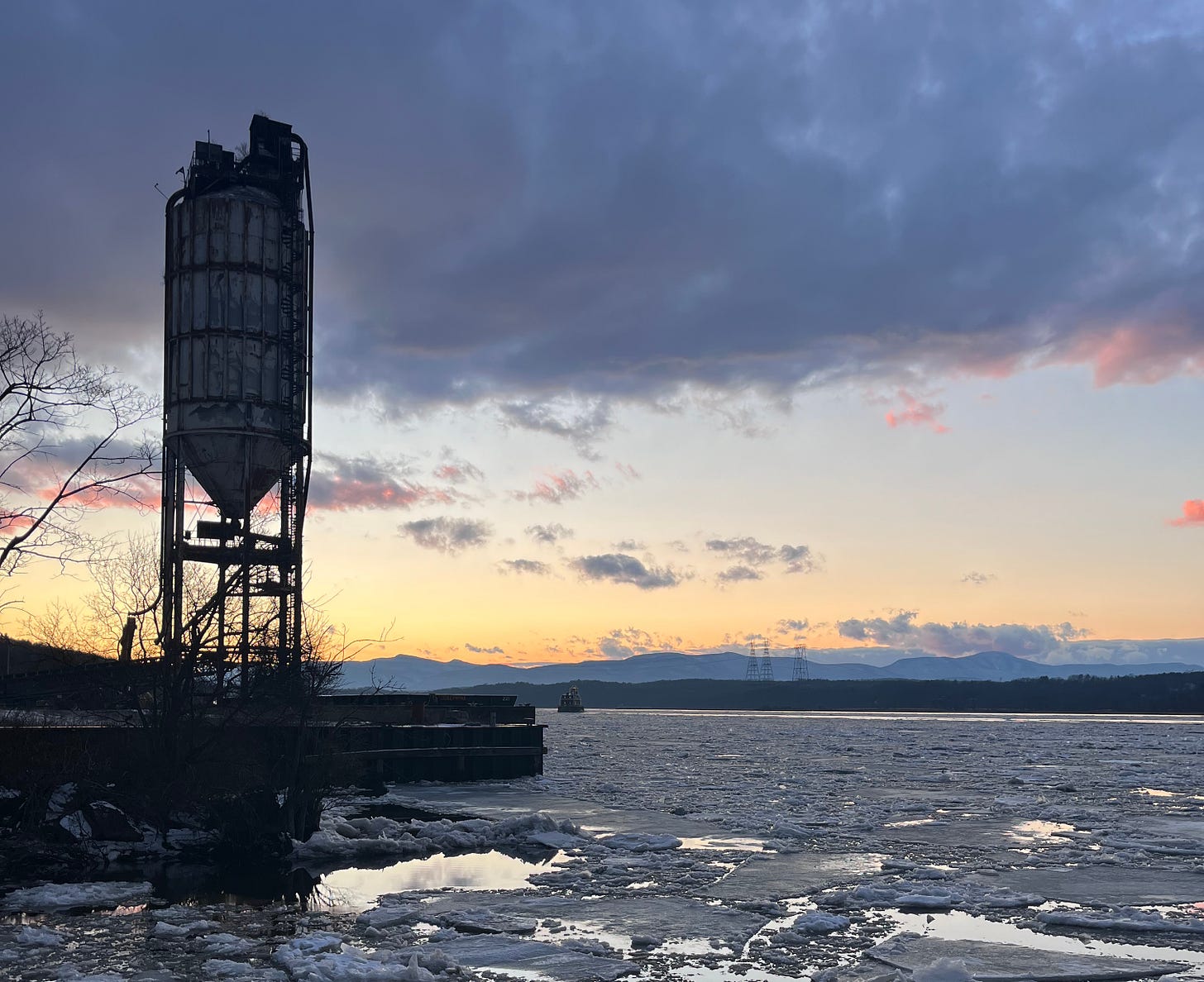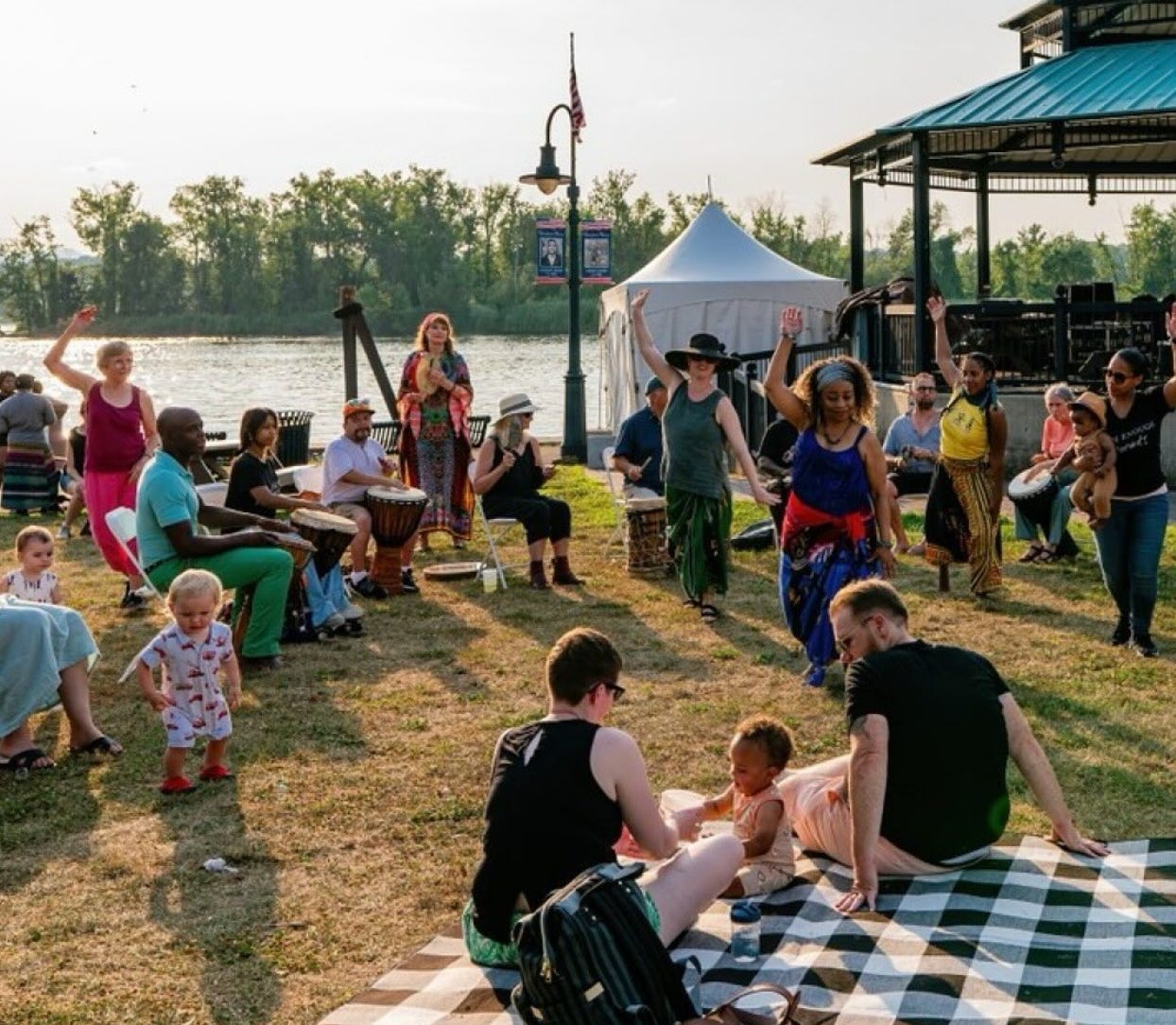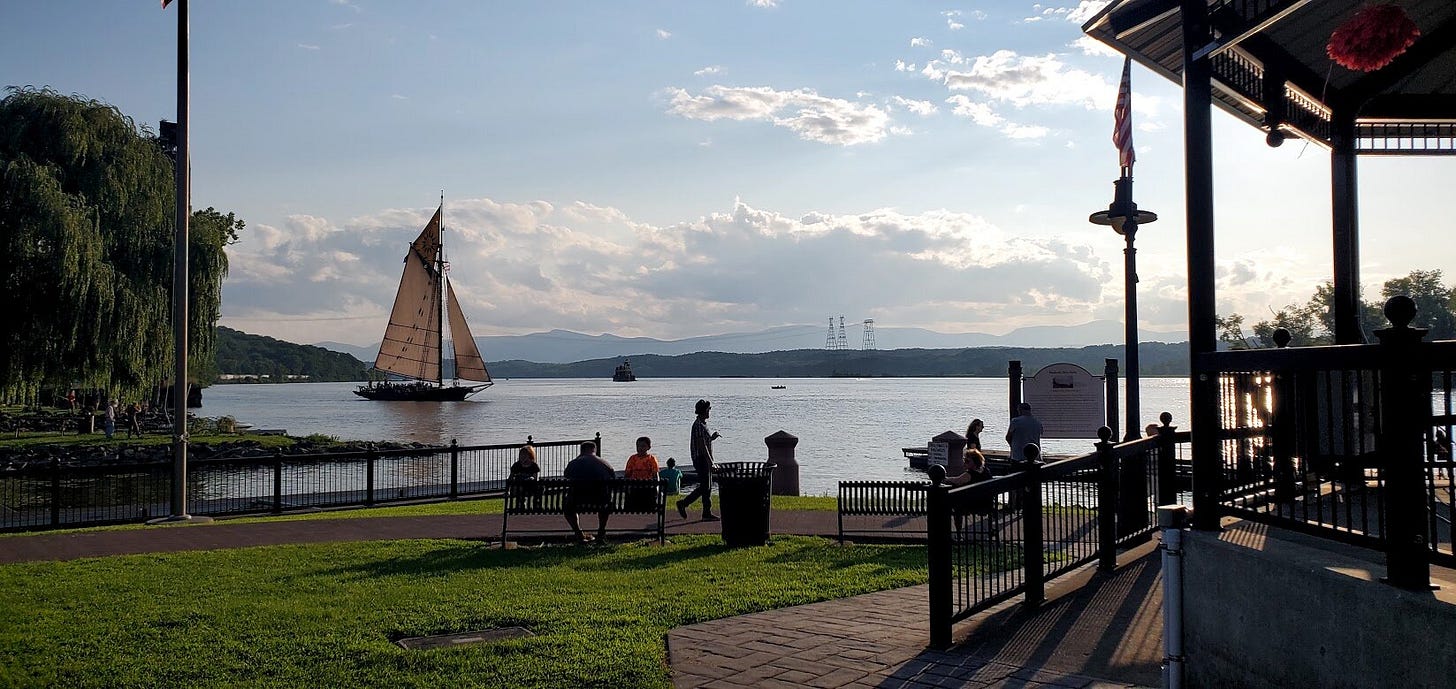Not Just Trucks and Dust: The Hudson Waterfront Debate
Trying to understand what the Colarusso discussion is really about
“Our waterfront should be a healthy, accessible public space, not a dusty industrial corridor.”
“No part of Hudson needs so many trucks uncovered and spewing gravel, dust and fumes, barreling through the streets.”
“The waterfront is our single greatest economic development opportunity… This is really a question about our shared prosperity.”
“It’s not just about Colarusso — it’s about who we want to be as a city, and who we’re doing the planning for.”
This week, I set out to finally catch up on the Colarusso controversy. I read through site plans, historical documents, and dozens of public comments and tried to understand what’s going on with the docks, the trucks, the permits, and the people who are weighing in about the waterfront.
I had, admittedly, lost the plot.
Since I moved back to Hudson in 2018, I’ve seen Colarusso’s name everywhere - on billboards and signs warning about gravel trucks, on flyers criticizing the haul road, in emails calling the community to show up at public hearings, and in texts from friends asking, “What do you think about this?” And until now, for better or worse, I haven’t really dug in.

And I think in part this is because when I heard “Colarusso,” I didn’t think of gravel trucks or zoning codes. I thought of the people I knew in town who have the name. It didn’t conjure an image of the quarry or a haul road. I knew the Colarusso family the way many people who grew up in Hudson did: by crossing paths with them in one way or another. In my case, it was Paul, in community theater as a kid. They were part of our community.
But of course, they’re also a business — a longstanding one. A. Colarusso & Son has been building roads, bridges, and infrastructure in Columbia County for over a century. Founded in 1912 by an Italian immigrant named Antonio Colarusso, the business grew from a small family business with a few contracts to a massive construction business, establishing a quarry in the 1930s and a blacktop plant in the 1950s. They’ve had their hand in just about everything around that’s been paved or poured around here — they even constructed the street I grew up on, by Oakdale. And they’ve been a vital employer too, providing consistent work for people in our community.

They’ve also given back to this community in significant ways. They’ve supported various local organizations and causes over the years, including Columbia Memorial Hospital, the Hudson Area Library, and the Columbia-Greene Community Hospice. In 2010, the Colarusso family received the Columbia County Association’s Distinguished Citizen of the Year in recognition of their contributions.
And yet, when I read through the comments, Colarusso is not described as a community-oriented employer with deep Hudson roots. Instead, they’re an industrial giant ignoring safety and health regulations, an organization that doesn’t belong on the waterfront anymore.
The core concerns of the community about Colarusso’s operations seem to be:
The impact of truck traffic on Hudson streets and air quality
Dust and noise pollution near the waterfront
The lack of compatibility between industry and a waterfront that many view as recreational and cultural
So after reading through the public comments, I read through historical documents to see where we are now.
Back in 2016, Colarusso repaired a 75-foot section of their dock’s bulkhead, swapping out old wood for steel — without going through the city’s Planning Board. This was a big deal. The dock had been operating under what’s called “non-conforming use status” — their operation was grandfathered in despite newer zoning that wouldn’t allow for such industrial uses along the waterfront. By making changes without approval, they got the attention — and ire — of the Planning Board and the broader community along with it.
That’s when the City required Colarusso to get permission to keep operating their dock — what’s known as a conditional use permit. This process has been drawn out for years, with lawsuits from both sides, environmental impact assessments, and many rounds of planning board review. In 2024, after a decade of hearings and litigation, a court affirmed that the bulkhead repairs terminated the dock’s non-conforming status, necessitating a conditional use permit; it was back to the beginning.
It’s worth noting that this isn’t Colarusso’s only active permit process. In 2023, the Planning board approved a permit for the company’s Haul Road – a private road that runs from their quarry in Greenport to the Hudson waterfront. The road was pitched as a way to reduce truck traffic on city streets, but many in the community viewed the approval as a quiet green light for expanded industrial use. So when the Planning Board initially declined to reopen a public hearing for the dock permit — arguing that the matter had already been reviewed — residents pushed back. They pointed to new board members, new legal precedent, and the combined impact of both the haul road and dock activity.
The public hearing held this past Tuesday in a sense wasn’t a routine hearing – it was a response to that pressure. That meeting drew around 70 people in person — necessitating a move to the firehouse to accommodate the group — and over 150 written comments. After hours of testimony, the Planning Board voted — controversially — to close the hearing, but they are accepting public comments until May 30th.
Colarusso’s legal team continues to argue that the Planning Board’s authority is limited — that any conditions must apply solely to the 75-foot bulkhead repair. But a 2024 state court ruling says otherwise: by making those repairs without approval, Colarusso forfeited its non-conforming use status. That means the Planning Board can now evaluate the full scope of dock operations under current zoning — including truck volume, dust mitigation, hours of use, and environmental impact.
So now, we wait. The Planning Board will eventually vote on the permit. But with competing interpretations of the law and competing visions for the future of the waterfront, it’s still unclear what exactly is being decided — and for whom.
After sitting with all the impassioned public comments this week, what stuck with me most was a consistent theme: a desire for a green, culturally active waterfront — one centered on wellness, recreation, and natural beauty. I want that too. I want my children to grow up feeling like the river is theirs, like I did — a space that feels fun and safe. I want them to have memories of Waterfront Wednesdays, of concerts in the gazebo, of fishing with their dad, of ferry rides. That vision resonates deeply with me.

But some of those comments didn’t land well with me. Comments with descriptions of the waterfront’s commercial value. A “first impression” of our community for tourists arriving on the Amtrak. A branding opportunity. A front door to Hudson’s future. There were many comments about restaurants, shops, curated experiences — the kind of amenities that make a place “desirable”. These comments made me bristle.
I tried to stay curious about my own reaction. And I think what it comes down to is I don’t want a waterfront designed to impress. I don’t want it to become unrecognizable to the people who grew up on the river. I don’t want it to become another place that we’re priced out of — whether financially or spiritually. And I wonder if that’s part of the reason I haven’t heard from people who grew up here on this issue. Not because we love gravel trucks or dust. But because we’re used to Colarusso. We’ve lived alongside them our whole lives. We have known folks who worked there. We’ve benefited from their charitable giving — long before new wealth moved into this community. We know how to live side-by-side with Colarusso — we always have.
We grew up with the quarry. With the barges. With the gravel — for better or worse. We know it, and it feels like it’s ours. That doesn’t mean that it should always stay that way. Nostalgia isn’t always the most practical emotion. But layered in there with nostalgia, for me, is fear — fear that significant change at the waterfront means change that doesn’t bring our whole community along. Does this mean that I want the gravel operations to expand? No. Does it mean I’m advocating for Colarusso? Also no. But I do think it’s meaningful to pause and ask why certain voices aren’t coming to the table.
Maybe part of the reason some voices aren’t showing up is because there’s just so much else to worry about in Hudson right now. We’re in the middle of an acute housing crisis. Rents are rising, evictions are increasing, and the future of Bliss Towers — the city’s largest affordable housing complex — hangs in the balance. We’re navigating conversations about charter change, local elections, and how power is distributed in this city. It can feel like there’s a new crisis every week. So while I’m encouraged by the turnout and passion around the waterfront, I also can’t help but wonder: what would it look like if we brought this same level of civic energy to housing? To tenant protections? To long-term community stability?
That’s the work of making Hudson livable — not just scenic, but truly sustainable for the people who call it home.
So do I have a take on Colarusso? Yes. After reading through the public comments, including multiple proposals and suggestions, I believe there’s a compromise to be found — one not created by developers or lawyers, but by the folks who actually live and work on the waterfront every day: The Hudson Riverfront Coalition, as they’ve called themselves in their comment to the planning board. This group is comprised of the Hudson Ferry Company, the Hudson Sloop Club, and the crew of the Schooner Apollonia. These are organizations that understand the river — its beauty, its working history, and its potential.
Their proposal includes common-sense conditions: limiting truck traffic to weekdays between 7 and 5, keeping out hazardous materials, and preventing any future expansion of industrial uses beyond what’s already permitted. These changes aren’t radical — they’re protective. They reflect the idea that if you’re going to operate in a sensitive, shared space, you have to meet the community where it’s at.
The Hudson Riverfront Coalition also suggests reclaiming some of what’s already ours. Like ensuring public access to the 4.4-acre parcel next to the dock — land that could help connect trails, open up green space, and give our kids a place to bike or walk along the water. They recommend opening the Haul Road for pedestrian and bike use when trucks aren’t running. This is how waterfronts work in other places — Red Hook (in Brooklyn), Baltimore, even San Francisco. Working waterfronts and public access can coexist. We just have to design for it.
This isn’t a final plan — it’s a bridge between what is and what could be. And to me, that’s what real community planning looks like. We deserve a waterfront that’s both beautiful and functional. Both rooted and visionary. Both for us and for what’s next.
For those of you who have been reading along weekly, thank you for being here! After feedback on the interview with Chief Mishanda Franklin, I’ve decided to regularly incorporate interviews (maybe monthly?). Who would you like to hear from? Leave a comment and let me know!
Thanks for reading — I love this community so much, and it’s such a joy to share my reflections with others and to hear from folks about their experiences too, whether you grew up here or you just got here.








Caitie, thanks for the update on the Colarusso matters.
I was struck by your comments about the gentrification of Hudson (my word, but hopefully encompassing your concerns). This resonates very much with me. In the forty years I lived in Cambridge, MA I watched our neighborhood transformed. In 1977 we bought a house that cost us about three times our family income. A doable stretch. When we left in 2009 for Hudson, the same house sold for 19 times what we bought it for. We could not have afforded to buy or rent in Cambridge at that point. Today our "worker's cottage" (that's the descriptor in the city's housing census) is listed for over $2 million and the owner makes $70,000 a year from renting out (AirBandB) a 450 sq.ft. one-bedroom apartment we had created after the kids left on their own adventures.
Then to Hudson in 2009. We could afford to buy a house right on Warren. Other things like a photography gallery ensued. When we left in 2024, again the housing costs had gentrified us out if we were moving in anew.
Now, in West Palm Beach, gentrification writ large is at our door again. With the surge of rich people and their attendings in the area, now referred to in the local press as Wall Street South, real estate developers are rushing to put up condo towers with units priced from $2 - 9 million. Recently a developer offered $150 million to buy our condo building (10 stories – 125 units built in 1969 – old by FL standards) as a tear-down! This isn't going forward, but that's another story. Just ten blocks north of us along the Intracoastal a developer bought up around forty small post-WWII bungaloos as tear downs so that they can build 30 story condo towers with untis priced in the same $2-9 million range.
Just in case you missed this: COLARUSSO FAMILY & ARMORY FIRE HUDSON NY 1928 https://youtu.be/TPsKEiyd5L0
Mark
I believe that more research and questions concerning our beautiful River waterfront are necessary before we invest in expanding the recreation.
The Hudson waterfront was a place for shipping goods and industrial sites.
Look up Wagon Way.
Since 1785 North and South Bays became landfill sites.
Hudson Iron Works was located on the Riverbank. Can’t imagine the soil pollution.
A glue factory was located near Basiica.
The smell from it was beyond description. Have to site of the Antique Warehouse.
Hundreds and maybe thousands of vehicles were crushed there.
And on and on with water and soil contamination.
Similar situation with the North Bay area.
Let’s include the Hudson dump on the North side too with no limits as to what was dumped in the ground.
Now add Hudson’s raw household and commercial sewage flushed into the river for decades.
And remember that for five days a week sewage trucks bring raw sewage to our water treatment plant. As if we don’t have enough of our own.
Let’s not forget that the same thing was occurring up and down the River from us too.
Would you drink Hudson River water? Or swim in it? Eat fish caught in it?
I’m sure that I missed additional issues with our beautiful waterfront.
So I believe that it’s best to let Colarusso have the brown fields and polluted Hudson all to himself.
And that we find a safer place for outdoor recreation and all to enjoy.
Stay safe.
best regards
Thomas D’Onofrio